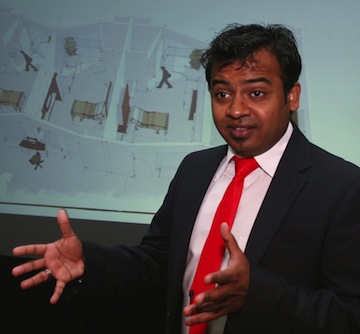Houston-based WHR Architects has named Lia Rodi, AIA, LEED AP, as the new curator of the firm’s Tradewell Fellowship Program, now in its 15th year. A past Tradewell Fellow, Rodi’s first official duty was the announcement of the 2012 Fellow Akshay Sangolli.
“It’s an honor to assume responsibility for the Tradewell program,” said Rodi. “Fourteen years ago, my own year as a Tradewell Fellow under the guidance of Kirk Hamilton was the ideal preparation for my new role. My experience and work with other Tradewells over the years has provided a model that will help to be of the best possible service to the Fellowship as a leader and mentor.”
Although internships are a tradition in the architectural profession, there are still few fellowships that offer recent graduates a focused opportunity to gain experience working closely with senior firm leaders and significant interaction with clients. This year’s Fellow, Akshay Sangolli, pursued the Tradewell in recognition of its exceptional nature. “It is a unique opportunity that puts you at an entirely different level at the outset of your career,” said Sangolli. “The Tradewell Fellowship offers [a] perfect combination of professional guidance, academic realization, and hands-on learning.”
The year-long Tradewell Fellowship was established by David Watkins, FAIA, president and chairman of WHR Architects, along with Kirk Hamilton, FAIA, FACHA, EDAC, now a professor at Texas A&M University and associate director for the Center for Health Systems and Design, in honor of the late Gary Tradewell, a former vice president and medical planner at WHR. The fellowship focuses on building careers of aspiring healthcare architects. Each year the Tradewell Fellow is involved with clients in early master planning and design, with a particular focus on healing environments and collaborative design methods as part of their employment at WHR. In addition to working directly with senior medical planners on design projects, Fellows receive career guidance from leaders at WHR and a network of past Tradewell Fellows.
In addition to project assignments, the Fellow also receives a scholarship to attend a healthcare architecture conference, and the opportunity to attend in-house educational presentations. Other educational opportunities include: assisting with teaching a graduate-level course on health facility planning, design, and construction; participating in evidence-based design activities; and assisting members of the firm in authoring speeches, articles, or books.
Fellows are selected by the group of past Tradewells at WHR, based on the strength of their design portfolios, letters of recommendation, and essays describing their accomplishments and career goals.
Sangolli, who began his fellowship in June, summarized his goals: “In the long term, I want explore how architecture can enhance human health, healing and well-being. I hope to participate in improving the quality of the built environment and its implications on human life around the world, especially in much-neglected developing nations.”
Related Stories
| Oct 11, 2011
ThyssenKrupp elevator cabs validated by UL Environment
The conclusive and independent third-party validation process is another step toward a green product line.
| Oct 11, 2011
Ballard Spahr launches real estate recovery group
The new group represents an expansion of the company’s Distressed Real Estate Initiative, which was launched in 2008 to help clients throughout the country plan, adapt and prosper in a challenging economic environment.
| Oct 11, 2011
Onex completes investment in JELD-WEN
With the completion of the JELD-WEN investment, Onex Partners III is approximately 40% invested.
| Oct 7, 2011
GREENBUILD 2011: Demand response partnership program announced at Greenbuild 2011
Program will use USGBC’s newly revised LEED Demand Response credit as an implementation guideline and leverage its relationships with the building community to foster adoption and participation in existing utility and solution provider demand response offerings.
| Oct 7, 2011
GREENBUILD 2011: Otis Elevator announces new contracts for sustainable building projects
Wins reinforce Otis’ position as leader in energy-efficient products.
| Oct 7, 2011
GREENBUILD 2011: UL Environment releases industry-wide sustainability requirements for doors
ASSA ABLOY Trio-E door is the first to be certified to these sustainability requirements.
| Oct 7, 2011
GREENBUILD 2011: UL Environment clarifies emerging environmental product declaration field
White paper defines EPD, details development process, and identifies emerging trends for manufacturers, architects, designers, and buyers.
| Oct 7, 2011
GREENBUILD 2011: Otis Elevator introduces energy-efficient escalator
The energy-efficient NCE escalator from Otis offers customers substantial “green” benefits.
| Oct 7, 2011
GREENBUILD 2011: Schools program receives grant to track student conservation results
To track results, schools will use the newly developed Sustainability Dashboard, a unique web-based service that makes tracking sustainability initiatives affordable and easy.
| Oct 7, 2011
GREENBUILD 2011: Transparent concrete makes its North American debut at Greenbuild
The panels allow interior lights to filter through, from inside.

















